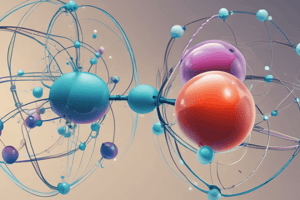Podcast
Questions and Answers
What is Orbitals?
What is Orbitals?
- The space around the nucleus where there is high probability to finding electrons (correct)
- A negatively charged subatomic particle that can be either bound to an atom or free.
- A subatomic particle with a positive electrical charge
- Describe where electrons are located around the nucleus of an atom.
What is the shape of p orbitals?
What is the shape of p orbitals?
- Spherical
- Four-leaf Clover shaped
- Dumbbell-shaped (correct)
- Circle
What is the shape of s orbitals?
What is the shape of s orbitals?
- Dumbbell-shaped
- Spherical (correct)
- Oval
- Circle
What is the shape of d orbitals?
What is the shape of d orbitals?
What are orbitals?
What are orbitals?
What is the shape of s orbitals?
What is the shape of s orbitals?
What is the shape of p orbitals?
What is the shape of p orbitals?
What is the shape of d orbitals?
What is the shape of d orbitals?
Study Notes
What are Orbitals?
- Orbitals are the areas around the nucleus of an atom where there is a high probability of finding electrons.
- They describe the likely locations and energies of electrons in atoms.
Types of Orbitals
-
s Orbitals
- Have a spherical shape.
- The nucleus is situated at the center.
- The size of the s orbital increases as the principal quantum number (n) increases.
- Each s orbital can accommodate a maximum of two electrons.
- S orbitals have the lowest energy level among all orbitals.
-
p Orbitals
- Have a dumbbell shape.
- There are three types of p orbitals (2px, 2py, 2pz), each oriented along one of the three axes (x, y, z).
- They have a nodal plane at the nucleus, where the probability of finding an electron is zero.
- Their size increases as the principal quantum number (n) increases.
- Each p orbital can accommodate a maximum of two electrons.
-
d Orbitals
- Have complex, cloverleaf-like or dumbbell shapes with a ring around the nucleus.
- There are five types of d orbitals (dxy, dyz, dzx, dx2-y2, dz2).
- They also increase in size with the principal quantum number (n).
- Important in the chemistry of transition metals, particularly in bonding and electron distribution.
- Each d orbital can accommodate a maximum of two electrons.
Orbitals
- Orbitals are regions around the nucleus where there's a high probability of finding electrons.
- The shape of an orbital describes the electron's probable location.
- Orbitals are filled in order of increasing energy level.
S Orbitals
- S orbitals are spherical, with the nucleus at the center.
- They have the lowest energy level.
- S orbitals increase in size with increasing principal quantum number (n).
- They can hold up to 2 electrons.
P Orbitals
- P orbitals are dumbbell-shaped.
- There are three p orbitals (px, py, pz) oriented along the x, y, and z axes.
- They are always positioned perpendicular to each other.
- They are found in energy levels starting from the second (n = 2).
- They have a nodal plane at the nucleus with zero electron probability.
- P orbitals increase in size with increasing principal quantum number (n).
- They can each hold up to 2 electrons.
D Orbitals
- D orbitals are more complex in shape, often resembling cloverleaves.
- There are five D orbitals (dxy, dyz, dzx, dx2-y2, dz2).
- D orbitals are found in energy levels starting from the third (n = 3).
- They increase in size with increasing principal quantum number (n).
- They are important for the chemistry of transition metals involved in bonding and electron distribution.
- They can each hold up to 2 electrons.
Studying That Suits You
Use AI to generate personalized quizzes and flashcards to suit your learning preferences.
Related Documents
Description
Explore the different types of atomic orbitals, including s, p, and d orbitals. This quiz covers their shapes, energy levels, and electron capacities, providing a clear understanding of where electrons are likely to be found around the nucleus. Test your knowledge on the foundational concepts of atomic structure.




